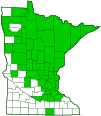spiny baskettail
(Epitheca spinigera)
Conservation • Description • Habitat • Ecology • Distribution • Taxonomy
|
|
|||||||||||||
Description |
Spiny baskettail is a common, medium-sized, emerald dragonfly. It occurs across the northern Untied States and southern Canada. In Minnesota it is fairly common in the northern two thirds of the state, mostly absent in the southwest corner and the southern counties. It is found from mid-May to mid-July in wooded areas at the marshy borders of small to medium-sized lakes and ponds and along slow streams. It is tolerant of acidic waters. It also forages in clearings often a long distance from water. Adults are 1½″ to 1⅞″ long. Unlike other emerald dragonflies (family Corduliidae), baskettails (genus Epitheca) do not show a metallic luster. The face is yellow to brown and there is a black T-shaped spot on the forehead (frons). The large compound eyes on both the male and female meet at the top of the head. They are iridescent blue on the mature male, green on the mature female, and reddish-brown on immature individuals of both sexes. On the female the eyes are less intensely green than on other emerald dragonflies. The thorax is dark brown with a yellowish-orange dot on each side. The abdomen is dark brown with a row of yellowish-orange spots on each. On the male it is spindle-shaped, constricted just beyond the base, widest at segment six, and tapered to the tip. At the end of segment 10 there is a pair of sensory appendages (cerci). On the male each cercus has a small, downward-pointing tooth. This tooth is the source of the word “spiny” in this species common name. On rare occasions this spine is absent. On the female, the cerci are long, as long as segments 9 and 10, and are close together. The female lacks a needle-like tube (ovipositor) on the underside of abdominal segment 9 to disperse her eggs. In place of this she has a flat, flexible plate (subgenital plate) on the underside of segment 8. The subgenital plate is forked from near the base into two lobes that extend slightly beyond the end of segment 9. It is like a forklift with which she carries her mass, or “basket” of eggs. This feature is the source of the common name of the genus, “baskettails”. The legs are black. The wings are clear except for a dark cell (stigma) on the leading edge near the tip. |
Size |
Total length: 1½″ to 1⅞″ |
Similar Species |
Habitat |
Wooded areas at marshy edges of ponds and lakes, along streams |
Ecology |
Season |
Mid-May to mid-July |
Behavior |
The male patrols within fifty feet of the shoreline. It is a fast flier and hovers often. |
Life Cycle |
Adults emerge en masse and are present in large numbers for a short period in the spring. The female carries a mass (basket) of 500 to 1,000 orange eggs under her abdomen atop her subgenital plate. To disperse the eggs she attaches the mass to a submerged plant. The mass unravels into a gelatinous string up to six inches long. |
Naiad Food |
Mosquito larvae, fly larvae, mayfly larvae, other aquatic insects, and aquatic shrimp. |
Adult Food |
Mosquitoes, flies, small moths, mayflies, flying ants, and almost any other soft-bodied flying insect. |
Distribution |
||
|
Sources Biodiversity occurrence data published by: Minnesota Biodiversity Atlas (accessed through the Minnesota Biodiversity Atlas Portal, bellatlas.umn.edu, 8/1/2025). Haarstad, J. 1997. The dragonflies of selected eastern Minnesota rivers. Report submitted to the Minnesota Department of Natural Resources. Unpaged. Steffens, W. P., and W. A. Smith. 1999. Status survey for special concern and endangered dragonflies of Minnesota: population status, inventory and monitoring recommendations. Final report submitted to the Natural Heritage and Nongame Research Program, Minnesota Department of Natural Resources. 54 pp. |
|
| 8/1/2025 | ||
Occurrence |
||
Fairly common |
||
Taxonomy |
|
Order |
Odonata (Dragonflies and Damselflies) |
Suborder |
|
Superfamily |
Libelluloidea |
Family |
Corduliidae (emeralds) |
Genus |
Epitheca (baskettails) |
Subordinate Taxa |
|
|
|
Synonyms |
|
Cordulia spinigera Tetragoneuria indistincta Tetragoneuria spinigera |
|
Common Names |
|
spiny baskettail |
|
Glossary
Cercus
One of a pair of small sensory appendages at the end of the abdomen of many insects and other arthropods. In Odonata, one of the upper claspers. Plural: cerci.
Frons
The upper front part of an insect’s face, roughly corresponding to the forehead.
Ovipositor
A tube-like organ near the end of the abdomen of many female insects, used to prepare a place for an egg and to place the egg.
Stigma
In plants, the portion of the female part of the flower that is receptive to pollen. In Lepidoptera, an area of specialized scent scales on the forewing of some skippers, hairstreaks, and moths. In other insects, a thickened, dark, or opaque cell on the leading edge of the wing.
Subgenital plate
In male Orthoptera, the plate-like structure extending from the lower (ventral) side of the end of the abdomen underlying the genitalia.
Visitor Photos |
||
Share your photo of this insect. |
||
This button not working for you? |
||
|
||
|
||
MinnesotaSeasons.com Photos |
||
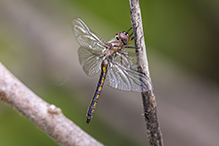 |
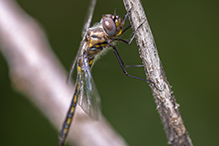 |
|
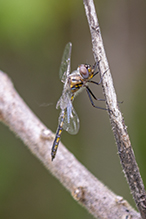 |
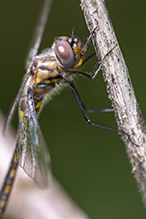 |
|
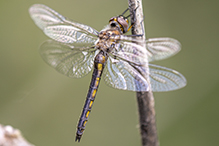 |
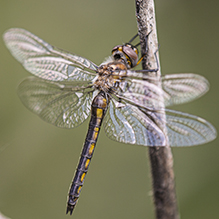 |

Slideshows |
|

Visitor Videos |
||
Share your video of this insect. |
||
This button not working for you? |
||
|
Other Videos |
||
Epitheca spinigera Feeding Swarm |
About
Jun 7, 2013 May 22, 2012 north central Wright County, MN. |
Émergence d'Epitheca spinigera |
About
May 24, 2016 Émergence massive d'Epitheca spinigera le 24-05-2016 AM. Parc de la Gatineau, QC. Étang de castor près de P9. Google translation: Massive emergence of Epitheca will spin on 24-05-2016 AM. Gatineau Park, QC. Beaver pond near P9. |

Visitor Sightings |
||
Report a sighting of this insect. |
||
This button not working for you? |
||
|
|
MinnesotaSeasons.com Sightings |
||

Created: 1/19/2020 Last Updated: © MinnesotaSeasons.com. All rights reserved. |
